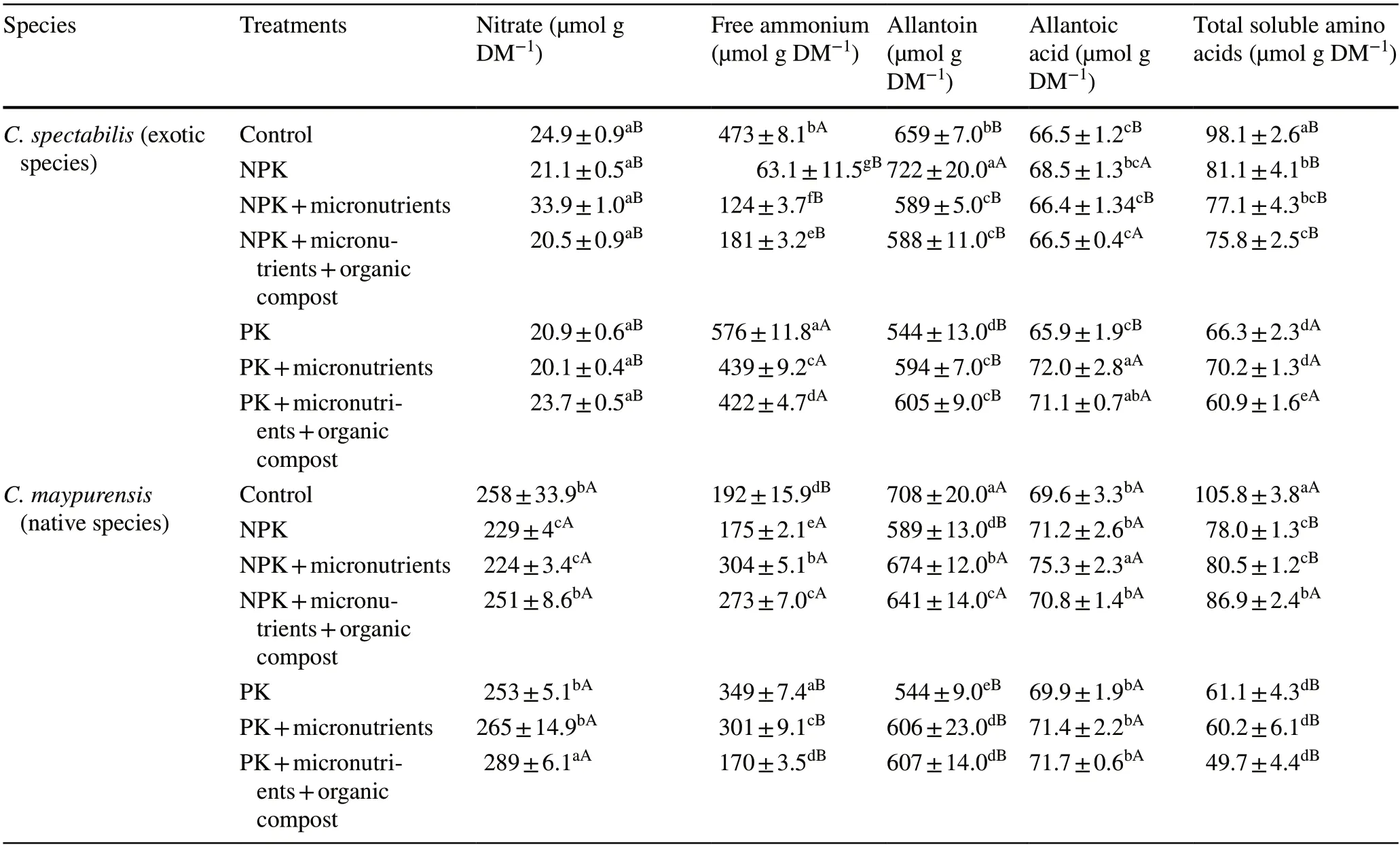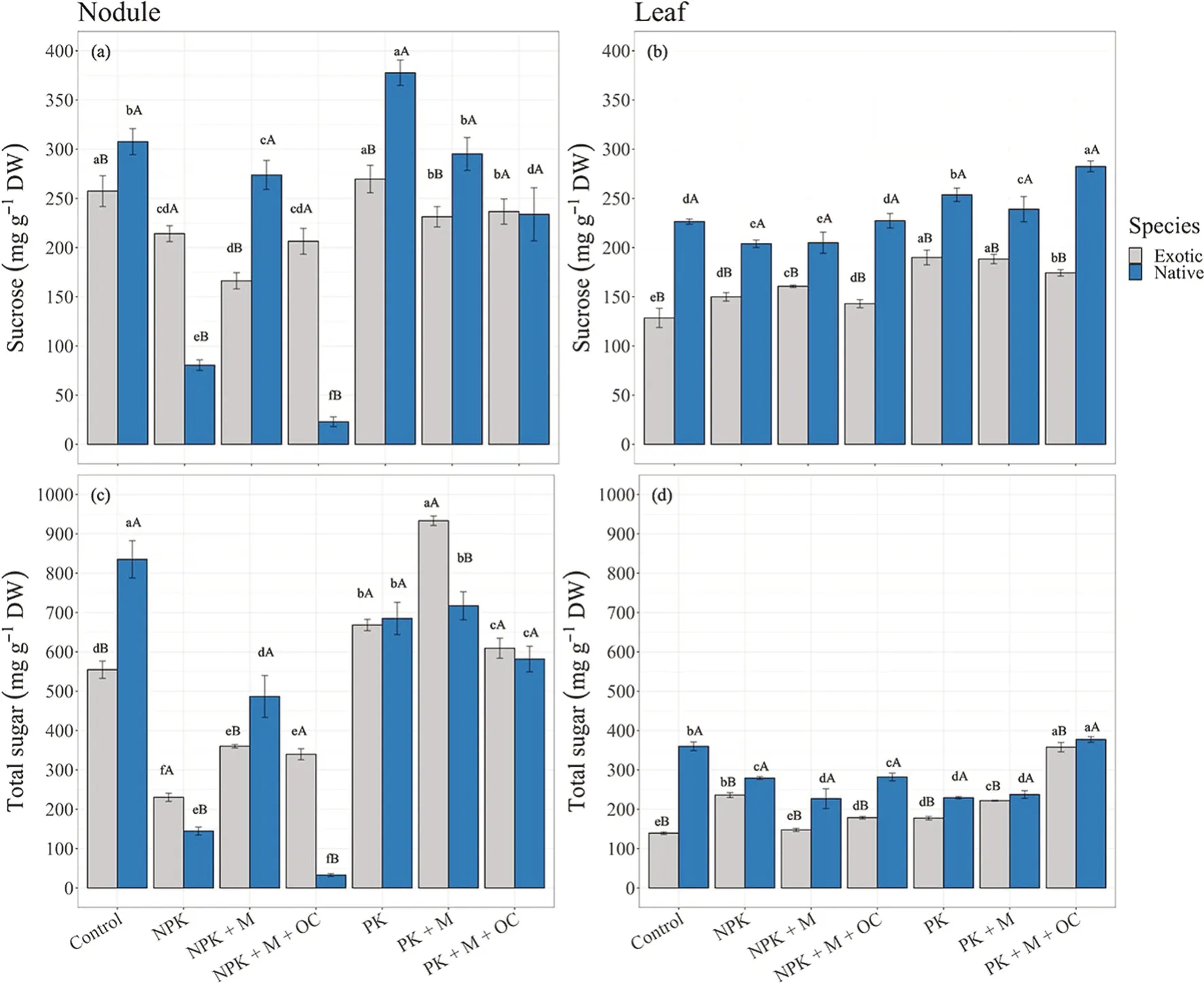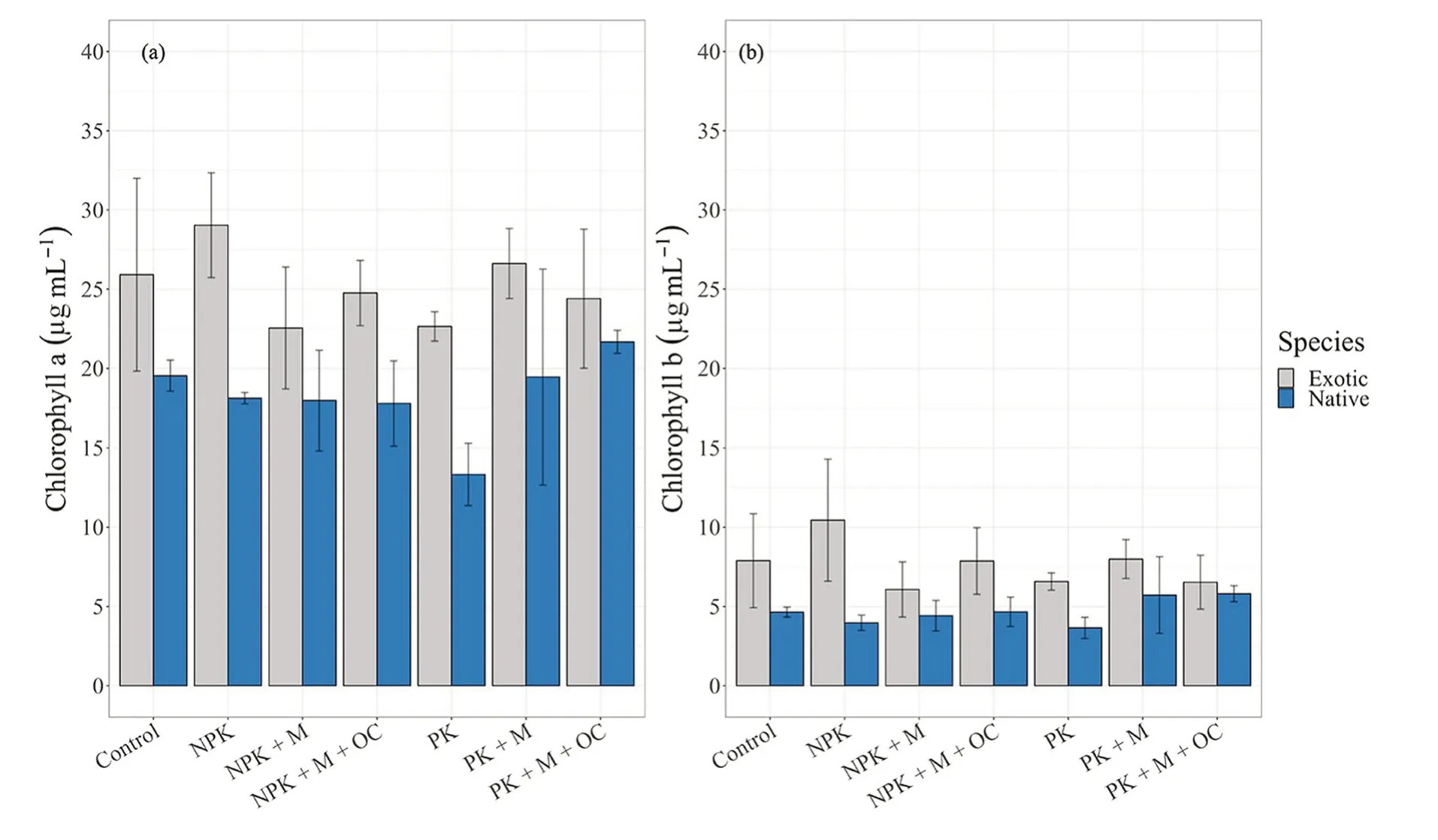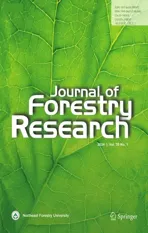Plant growth and metabolism of exotic and native Crotalaria species for mine land rehabilitation in the Amazon
2024-01-26HemelynSoaresdasChagasRafaelSilvaGuedesMarkusGastauerPaulaGodinhoRibeiroAllanKlyngerdaSilvaLobatoCeclioFroisCaldeiraFabrcioWilliamdevilaAndrRodriguesdosReisSilvioJunioRamos
Hemelyn Soares das Chagas · Rafael Silva Guedes · Markus Gastauer ·Paula Godinho Ribeiro · Allan Klynger da Silva Lobato · Cecílio Frois Caldeira ·Fabrício William de Ávila · André Rodrigues dos Reis · Silvio Junio Ramos
Abstract Despite its enormous benefits,mining is responsible for intense changes to vegetation and soil properties.Thus,after extraction,it is necessary to rehabilitate the mined areas,creating better conditions for the establishment of plant species which is challenging.This study evaluated mineral and organic fertilization on the growth,and carbon and nitrogen (N) metabolism of two Crotalaria species [Crotalaria spectabilis (exotic species) and Crotalaria maypurensis (native species from Carajás Mineral Province (CMP)]established on a waste pile from an iron mine in CMP.A control (without fertilizer application) and six fertilization mixtures were tested (i=NPK;ii=NPK+micronutrients;iii=NPK+micronutrients+organic compost;iv=PK;v=PK+micronutrients;vi=PK+micronutrients+organic compost).Fertilization contributed to increased growth of both species,and treatments with NPK and micronutrients had the best results (up to 257% cf.controls),while organic fertilization did not show differences.Exotic Crotalaria had a greater number of nodules,higher nodule dry mass,chlorophyll a and b contents and showed free ammonium as the predominant N form,reflecting greater increments in biomass compared to native species.Although having lower growth,the use of this native species in the rehabilitation of mining areas should be considered,mainly because it has good development and meets current government legislation as an opportunity to restore local biodiversity.
Keywords Biological nitrogen fixation · Mining ·Nitrogen metabolism · Plant nutrition
Introduction
Ferruginous cangas are ecosystems associated with a superficial iron crust,with vegetation typical of rupestrian fields associated with the rocky substrate (Viana et al.2016).These areas are home to species adapted to extreme conditions such as acidic soils,low nutrient content and water availability,and high temperatures (Mota et al.2018).The Amazon cangas are in the National Forest of Carajás and Campos Ferruginosos National Park,in Carajás Mineral Province (CMP),eastern Amazon.The CMP is an important mineral province,containing the largest iron (Fe) reserves,with potential for the exploration and export of bauxite,manganese,gold,copper,nickel,and kaolin (Teixeira et al.2021).Despite the enormous mineralogical potential of the CMP,it is necessary to recognize that mining is also responsible for the intense change in land cover and use (Sonter et al.2014).
Revegetation is the most applied technique to rehabilitate mined land.However,the main challenge is establishing species capable of adapting to post-mining environments (Ramos et al.2019).Due to mineral extraction and the removal of organic matter and minerals,mine lands are extremely depleted in nutrients and have severe changes in their physical,biological,and chemical properties (Pourret al.2016;Gastauer et al.2019a;Ramos et al.2022).During selection of the species for planting,the growth and accumulation of biomass must be considered,as they contribute to the improvement of soil organic matter,soil protection,and nutrient cycling,which facilitate the establishment of new individuals (Silva et al.2018;Pratiwi et al.2021).
The use of a wide variety of native species is mandated by legal norms in Brazil for rehabilitation purposes because they comprise the community adapted to the characteristics of the region and will contribute to the return of ecosystem services (Gastauer et al.2019b,2021;Ramos et al.2019).According to Gastauer et al.(2019a),functional characteristics of native species such as their nutrient accumulation and adaptation to the local environment,place the species among those with the highest chance of success for the rehabilitation of mined areas.At the same time,in Brazil,if it is technically justified,it is permissible to consider introducing non-invasive exotic species as a means of enhancing the establishment of native species (ICMBio 2014).However,exotic species may negatively impact the diversity of communities and threaten the success of rehabilitation (Gastauer et al.2021).
Among species used in initial mine land rehabilitation to improve the physical,chemical,and biological properties of the soil,those of the Fabaceae family are exceptional,as they help in the structuring and stabilization of soil aggregates,contribute to high organic matter and improve biological activity (Costa et al.2021;Pratiwi et al.2021).The genusCrotalaria(subfamily Papilionoideae,tribe Crotalarieae) is one of the five largest in the Fabaceae family (Lewis et al.2005;Mattos et al.2018).Crotalariaspecies associate with nitrogen-fixing bacteria and improve soil N availability (Berriel et al.2022) and plant growth in mining areas.
Crotalaria spectabilisRoth is an exotic species from tropical Asia that adapts to poor soils and has been studied and used for revegetation of mined areas (Melo et al.2014;Zanchi et al.2021) and for green fertilization (Mauad et al.2019).Crotalaria maypurensisKunth,on the other hand,is the only nativeCrotalariaspecies from canga environments in Serra dos Carajás (eastern Brazilian Amazon) and has the potential to be used for the rehabilitation of degraded areas.It is a species that has rapid growth and easily propagated,as it produces abundant seeds with good germination (Mattos et al.2018).In addition,under ideal conditions,the species produces a large amount of biomass.
The use of the nativeC.maypurensismay represent environmental and economic gains in the process of land rehabilitation.However,studies are needed on its performance in mining sites to better understand its growth and nutritional requirements (Carvalho et al.2017).In addition,it is important to understand the effect of N metabolism on plant growth (Carlisle et al.2012).Thus,the objective of this study is to evaluate mineral and organic fertilization on the growth,nodulation,and the production of N compounds byC.maypurensiscultivated on mine waste and compare it with exoticC.spectabiliscurrently being used for mine land rehabilitation.The potential of bothCrotalariaspecies for the rehabilitation of Fe mining waste will be evaluated on their metabolism (i.e.,evaluation of N inorganic forms)and its impact on growth.
Materials and methods
Substrate characterization and fertilization treatments
The substrate used for plant establishment was a post mining substrate,i.e.,raw materials brought from the C horizon after Fe ore extraction.The material has very low levels of organic matter (0.5%) and nitrogen (N) (0.05%)(Table 1).Therefore,to test N and organic fertilization together with basic fertilization normally applied in the field (PK and micronutrients),six fertilizations were tested:(i=NPK;ii=NPK+micronutrients;iii=NPK+micronutrients+organic compost;iv=PK;v=PK+micronutrients;vi=PK+micronutrients+organic compost).The control was without fertilizer application.A commercial organic compost (plant parts from different species with a sandy loam soil-ratios confidential) is routinely applied in revegetation activities in CMP (Guedes et al.2021) (Table 1).In this study,it was applied at 5% rate (5/95 compost/soil mixture).With regards to the nutrients,the amounts were: 75 mg N;185 mg P,75 mg K;0.5 mg B;1.5 mg Cu;0.15 mg Mo;5 mg Zn per dm3of mining waste as Ca(NO3)2;CaH4P2O8;KCl;H3BO3;CuSO4.5H2O;Na2MoO4,and ZnSO4.The chemical characterizations of both mine waste and organic compost followed the methodology of Teixeira et al.(2017).

Species and seed treatment
Two species of the genusCrotalariawere used,namely,C.spectabilis,a commercial/exotic species,andC.maypurensis,native to the Brazilian Amazon ferruginous cangas.A detailed morphological description ofC.maypurensisis in Mattos et al.(2018).The species were selected due to its presence near mining areas (C.maypurensis) and its use in reclamation projects in CMP (C.spectabilis).
Seeds of the native species were collected in the canga areas close to iron ore mines of Carajás at the end of the fruiting period and before the opening of the pods to maintain maximum germinative potential.The seeds of the exotic species were acquired in specialized trade and are widely marked in Brazil for environmental recovery purposes.Before sowing,seeds of the twoCrotalariaspecies were submitted to dormancy breaking with manual scarification for a homogeneous germination.
Experimental design and growing conditions
The study was carried out in a greenhouse with an average temperature of 28 °C.The experiment was a completely randomized design with four replicates of the two species combined with a control and six substrate fertilization treatments(Fig.S1).Five seeds of eachCrotalariaspecies were sown separately in pots containing 2.5 dm3of mining waste.A solution containing the micronutrients was applied at time of sowing,while concentrations of total N,P,and K were subdivided with applications at sowing and 36 days after sowing to optimize availability and avoid nutrient losses.Both solutions were applied directly on the soil surface.Twenty days after emergence,seedlings were thinned to one plant per pot.The seedlings were cultivated for 90 days,irrigated daily with deionized water and keeping the humidity at 70% of field capacity.
Growth parameters
After 90 days of cultivation,height measurements were taken with a graduated tape with the apical meristem as standard.Plants were washed with distilled water and dried in an oven at 65 °C until constant weight.Shoot dry matter (SDM) and root dry matter (RDM) were subsequently determined.
Nodule measurements and N accumulation in shoots
The seeds were not inoculated with rhizobium bacteria,however,nodule number per plant (NN),nodule dry matter(NDM),and nodulation efficiency (NE) were determined as both species perform biological N fixation.For N analysis,leaves were collected from the plant,ground,dried at 65 °C until constant weight and N content was determined according to Malavolta et al.(1997).NE is the ratio between total-N content in shoot dry matter (g) and NDM (g) (Melo and Zilli 2009).Nitrogen accumulation in shoots (NAS)was calculated as the ratio between shoot dry matter (g) and total-N content (Claessen 1997).
Nitrogen and carbon compounds
These compounds in leaves and nodules were extracted according to Bieleski and Turner (1966).Material of both species was sampled in the morning at the time of harvest.For each gram of dry material,10 mL and 5 mL of MCW solution (60% methanol,25% chloroform,15% deionized H2O) was added for leaf and nodule sample,respectively.A 1 mL chloroform+1.5 mL H2O was then added for each 4 mL supernatant.After separation,the water-soluble phase was used for analysis of the following nitrate (NT) (Cataldo et al.1975),free ammonium (FA) (McCullough 1967),allantoin (AL) and allantoic acid (AA) (Vogels and Van der Drift 1970),total soluble amino acids (TSA) (Yemm and Cocking 1955),sucrose (SU) and total sugars (TS) (Bieleski and Turner 1966).
Photosynthetic pigments
For the quantification of chlorophyllaandb,fully developed leaves were taken from each plant in the moment of harvest and stored at -80 °C.A 0.2 g of leaf tissue was then macerated in liquid N and transferred to a Falcon tube which was topped up to 10 mL with 90% acetone (v/v).The extracts were stored for 24 h in the dark before centrifuging at 300 rpm for 20 min.The supernatant was then diluted to 1 mL of sample to 4 mL of acetone.The samples were transferred to quartz cuvettes and the absorbance measured in a spectrophotometer (ICP-AES Spectro Genesis,Kleve,Germany).Concentrations of chlorophyllaandb(µg mL-1)were determined according to Jeffrey and Humphrey (1975).
Statistical analysis
The data were submitted to analysis of variance after being checked for normality using Shapiro–Wilk test.Means of treatments were compared by Duncan’s test at 5% probability.Statistical analyses were performed in R environment version 3.6.1 (R Core Team 2019).
Results
Growth parameters
Height of the exoticCrotalariawas higher than the native species in all treatments (Fig.1a).Application of fertilizers in the exotic species did not result in height gains compared with the control.Conversely,for the native species,the PK,PK+micronutrients,and PK+micronutrients+organic compost treatments increased heights (up to 31.4%).

Fig.1 a height,b shoot dry matter production and c root dry matter production in two Crotalaria species cultivated with organic and mineral fertilizers;columns with different lowercase letters between fertilization under equal species and capital letters between species (C. spectabilis and C. maypurensis) under equal treatments indicate significant differences from the Duncan test (P <0.05);vertical bars Standard deviation (n=4).Control No fertilizers,OC Organic compost.
The exotic species produced more biomass with increments up to 300% in dry root biomass (NPK+micronutrients) and 236% in dry shoot biomass (PK+micronutrients+organic compost) (Fig.1b,c).BothCrotalariaspecies produced high shoot and root biomass with NPK+micronutrients,up to a 257% compared with the control.Organic compost increased biomass,however,there was no effect when compared with NPK+micronutrients treatment.
Nodule measurements
In this study,the species were not inoculated with rhizobium bacteria,however nodulation occurred in both species.Nodule number was higher in the exotic species,especially with the application of PK (Fig.2a).For the native species,there was no effect of fertilization on nodulation.The absence of N fertilization allowed for greater nodule dry matter in both species except for the NPK+micronutrients treatment (Fig.2b).

Fig.2 a nodule number,b nodule dry matter production,c nodulation efficiency and d N shoot accumulation in two Crotalaria species cultivated with organic and mineral fertilization.Columns with different lowercase letters between fertilization under equal species,and capital letters between species (C. spectabilis and C. maypurensis)under equal treatment indicate significant difference from Duncan’s test (P <0.05).Vertical bars represent standard deviation (n=4);control=without addition of fertilizers;OC Organic compost.
Native species generally showed higher nodulation effi-ciency through NPK,NPK+micronutrients,and PK treatments (Fig.2c).For the exotic species,the highest nodulation efficiency was in the control treatment and did not differ from the native species.In general,C.spectabilisaccumulated more N in the shoots than the native species (Fig.2d).The exotic species was responsive to treatments with and without N,with the highest increments with PK+micronutrients (149%) and PK+micronutrients+organic compost (161%).
Nitrogen and carbon compounds
The nitrate concentration in the leaves was higher than that in the nodules for both species (Tables 2 and 3).The nativeCrotalariahad the highest nitrate concentration in the PK+micronutrients+organic compost (leaves) and PK (nodules) treatments.For the exotic species,there was no effect of fertilization.The exotic and native species had lower free ammonium concentrations in the leaves and nodules,respectively,with NPK-based treatments (Table 3).
Ureides (allantoin and allantoic acid) were higher in the nodules compared with the leaves,regardless of the species (Tables 2 and 3).The native species had the highest allantoin concentration in the leaves in treatments without fertilization (control),NPK+micronutrients,and NPK+micronutrients+organic compost.NPK treatment resulted in a higher concentration for the exotic species.In the nodules,the exotic species had the highest allantoin concentration with NPK and PK,however,the native species had the highest averages with NPK+micronutrients+organic compost and PK+micronutrients+organic compost (Table 3).
In general,the native species had higher allantoic acid levels than the exoticCrotalariaspecies,with the highest averages in leaves with NPK+micronutrients (8% higher than control) and in nodules with PK (15.3% higher than control) (Tables 2 and 3).The highest allantoic acid average in nodules for the exotic species was in the NPK treatment,with 6.5% increments compared with control (Table 3).
The concentration of total soluble amino acids in leaves was lower than in nodules for both species (Tables 2 and 3).The native and exotic species had the highest levels in the leaves in the control (Table 2).In the nodules,in general,the native species had higher averages compared to the exoticCrotalariaspecies.The highest levels with fertilization were with NPK (41.9%) and PK+micronutrients (7.5%) for exotic and native species,respectively.

Table 2 Leaf nitrogen compounds in two Crotalaria species cultivated with organic and mineral fertilizers

Table 3 Nodule nitrogen compounds in two Crotalaria species cultivated with organic and mineral fertilizers
Sucrose concentrations in the leaves were higher in the native species for all treatments (Fig.3b).The highest averages were with PK+micronutrients+organic compost for the native species,and PK and PK+micronutrients for the exotic species,with an increase of 24.5% and 47.8%,respectively,compared with controls.The highest sucrose concentrations in the nodules were with PK application for both species.

Fig.3 a concentrations of nodule sucrose,b leaf sucrose,c total nodule sugars,d and total leaf sugars (d) in two Crotalaria species cultivated under different mineral and organic fertilization treatments;columns with different lowercase letters between fertilization under same species and capital letters between C. spectabilis and C. maypurensis under the same treatment indicate significant differences from Duncan’s test (P <0.05).Vertical bars represent standard deviation(n=4).Control=without addition of fertilizers,OC Organic compost.
In general,total sugars were higher in the nodules compared to the leaves (Fig.3c,d).In the leaves,the native species also had the highest averages,and the PK+micronutrients+organic compost was the best treatment.The nodules of the exotic species had the highest average sugars in the treatment with PK+micronutrients and the native species with control.
Photosynthetic pigments
For chlorophyllaandb,there was a response only as a function of the species.C.spectabilishad higher chlorophyll levels than the nativeC.maypurensisfor all treatments (Fig.4).

Fig.4 Concentrations of a chlorophyll a and b chlorophyll b in leaves of C.spectabilis and C. maypurensis cultivated under different treatments;Vertical bars represent standard deviation (n=4).No significant Species X Treatment interaction was observed,but exotic species significantly increased chlorophyll levels according to Duncan’s test (P <0.05).Control=without addition of fertilizers,OC Organic compost
Discussion
Growth and compound production in Crotalaria species
Heights of the exoticCrotalariaspecies were superior to the native species in all treatments.However,there were significant height gains for the native species when treated without N addition.In a study by Mangaravite et al.(2014),there was no effect of N fertilization on shoot production for the legumesCanavalia ensiformis(L.) DC.,Cajanus cajanvar.Flavus DC.,Mucuna deeringiana(Bort) Merr andCrotalaria junceaL.This is especially relevant for the rehabilitation of mined areas,where N is often a limiting factor (Ramos et al.2022).
Fertilization without N also allowed greater nodule dry matter production in native species.Another study with legumes reported nodule number and size significantly inhibited by the application of N fertilizer (Uddin et al.2008).Soybean nodulation may also be inhibited with nitrate supply (Yamashita and Cocking 2019).This may be explained by the interference of N in the synthesis of flavonoids,metabolites with critical functions in molecular communication between plants and N-fixing bacteria (Liu and Murray 2016).In the pre-infection stage,plants exude different substances through the roots,such as carbohydrates,amino acids,and phenolic compounds (flavonoids),creating a chemical gradient in the rhizosphere and resulting in the attraction of bacteria to root surfaces (Mandal et al.2010).Flavonoid levels decrease with N application,promoting less chemotaxis and,consequently,less bacterial infection in the roots,i.e.,a decrease or inhibition of nodulation.
The absence of N generally increased ureides concentrations.These compounds are the main forms of N transport in plants from N biological fixation,being transferred from the nodules to the shoots through the xylem (Carter and Tegeder 2016)–which explains their greater concentration in the nodules compared to leaves,regardless of the species studied.When N biological fixation occurs,a more intense synthesis of ureides occurs,which may be the best way to evaluate nodulation efficiency in legumes that transport these compounds (Camargos and Sodek 2010;Izaguirre-Mayoral et al.2018).
NativeCrotalariaspecies increased biomass with all treatments,which highlights the important role of fertilization in the growth of this species to start revegetation activities on sites depleted in nutrients such as mined areas.These results corroborate studies by Silva et al.(2018) when they reported an increase in initial growth of four native Fabaceae species from cangas of the CMP when cultivated in fertilized substrates.Other studies concluded that fertilizers should be applied whenever possible to promote legume growth and successful revegetation(Huda et al.2007;Uddin et al.2009;Ramos et al.2019).
Although organic fertilization increased biomass,its application in the test conditions could be suppressed as it reduced or did not affect total biomass production compared to treatment with NPK and micronutrients for both species.On the other hand,the addition of micronutrients had positive effects on growth,demonstrating that mineral fertilization had a higher impact on the studiedCrotalariaspecies.Vidal et al.(2020) also found that organic amendments,produced through composting without clay addition,had no or negative effects onLolium perenneL.andPhaseolus vulgarisL.growth.They associated the results with the maturity stage of the compost.
Scoring species
The exoticCrotalariaspecies had better dry mass production.Our results demonstrate thatC.maypurensisandC.spectabilishave different metabolisms in the presence of inorganic forms of N (nitrate and free ammonium).The assimilation of NO3–has a higher energy demand compared to the assimilation of NH4+,which needs to be previously reduced to ammonium during the formation of N compounds(Guo et al.2007).Nitrate concentration was higher in the native species (its main form of N uptake) and since its assimilation demands greater energy compared to that of free ammonium,the native species had lower growth and biomass production (Carlisle et al.2012).
In addition,the higher concentrations of chlorophyllaandbfor exotic species may be involved in the increased biomass since they are the energy point in the plant allowing greater production of photoassimilates (Oliveira et al.2015).The greater nodulation by the exotic species may have influenced the increase of N accumulation in the leaves and consequently,chlorophyll levels.Greater N availability triggers the increase of chlorophyll in leaves because nitrogen is essential during chlorophyll biosynthesis (Bassi et al.2018).
With regards to the nativeCrotalaria,it showed higher nodulation efficiency than the exotic species yet had lower nodule numbers and nodule dry matter.Although these variables are linked,it is important to note that this effi-ciency is possibly conditioned by the presence of active nodules (Fischinger and Schulze 2010).Hossain et al.(2018)also found that increased nodulation or nodule biomass did not always result in increased N2-fixation and explained this by N2-fixation efficiency.In spite not knowing the N amount from N biological fixation,it can be assumed that the differences in N accumulation come from the activity of the nodules,considering that plants obtained similar growth with or without N supply (Bourion et al.2007).
NativeCrotalariahad the highest total soluble amino acid levels in the nodules.These compounds are related to an additional amount of N for nitrogen-fixing bacteria metabolized in root systems and transported to the shoots in the form of amino acids (Moreira et al.2014).Thus,total soluble amino acids have a direct effect on N biological fixation,modifying nitrogenase enzyme activity (Reis and Döbereiner 1998) and justifying the growth of native species(shoot and root dry mass).
The nativeCrotalariahas potential for soil rehabilitation in mined areas of the CMP,and can contribute to the soil N.In this context,N biological fixation favours reduction of the levels of fertilizers applied,the cultivation costs and environmental impacts,the support for the rehabilitation of degraded areas,especially where the loss of soil organic matter was intense.The advantages of the native species may be related to the better adaptation to areas of canga,characterized by a strong incidence of solar radiation,shallow soils with a high concentration of metals,high temperatures and strong water seasonality,and marked by severe droughts(Mattos et al.2018;Silva et al.2018).These conditions indicate adaptations of C.maypurensiswhich may contribute to growth in areas such as in substrates after mining.
To summarize,the greatest contribution to N input without the need to add an external N source,the overall robustness and contribution to the protection of endangered canga flora with the native species stand out.At the same time,the exotic species has benefits such as greater growth and overall enhanced performance.Therefore,based on these experimental conditions,bothCrotalariaspecies are suitable for the rehabilitation of mined substrates in areas of the Brazilian Amazon ferruginous cangas.However,considering competitive exclusion risk for hybridization,further studies are needed to analyze the competition of both species with a risk assessment before their introduction.
In addition,mining sites differ in terms of substrate depth,soil physical attributes,content of toxic elements,rainfall,and temperature regimes,and all these conditions should be examined to better understand species adaptability to mine soil.Further studies should also assess changes in critical substrate attributes over long periods of time or with repeatedCrotalariaspecies cultivations.
Conclusions
This research showed that mineral fertilization contributed to the enhanced growth ofCrotalariaspecies.Treatments based on NPK and micronutrients had the best results for both species,showing the need for fertilization with all nutrients in mining waste soils to promote higher plant growth.In general,organic fertilization did not result in satisfactory differences.
The exoticCrotalariaspecies accumulated more N and chlorophyll,resulting in greater biomass production compared to the native species.In contrast,the native species showed nitrate as the predominant form of N in leaf tissues,which may be one of the reasons to the lower growth of this species since more energy is spent to metabolize nitrates in plant tissues.
Considering the higher nodulation efficiency and considerable biomass production,the native species can be promising in programs to rehabilitate mined areas,with evidence for the ecosystems found in the CMP,mainly by the fast growth and persistence,which contributes to the protection of endangered canga flora and also meets legal requirements.Planting both species together may have the benefits of rapid growth and high biomass ofC.spectabiliswith the biodiversity ofC.maypurensis.Further studies should be carried out to analyze the competition of both species to better understand their adaptability to mining sites.
杂志排行
Journal of Forestry Research的其它文章
- Physiological and psychological responses to tended plant communities with varying color characteristics
- Annual growth of Fagus orientalis is limited by spring drought conditions in Iran’s Golestan Province
- Climate‑change habitat shifts for the vulnerable endemic oak species (Quercus arkansana Sarg.)
- Peat properties of a tropical forest reserve adjacent to a fire-break canal
- Impact of cattle density on the structure and natural regeneration of a turkey oak stand on an agrosilvopastoral farm in central Italy
- Climate-growth relationships of Pinus tabuliformis along an altitudinal gradient on Baiyunshan Mountain,Central China
